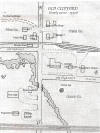|
|
|
|
A Bit of Finnish History in North Central Wisconsin
Written By: Judy Korpela Schoch as published in Finn Talk, Central Wisconsin Finnish American Club Newsletter. Part 1 - Spring 2010 and Part 2 - Autumn 2010. Reprinted with permission.
(Click on thumbnails to view photos)
Part 1:
This map is one I recently found among my father, Oliver Korpela's, papers. I found some information, too. I always thought that Old 8 ran along the tracks northeast of the creek, but I believe Dad said once that they didn't move it there until the side track for the railroad was removed. He said it originally ran south of the Clifford Co-op where it is shown on the map.
The road going north and south is actually County Road YY which ran over the truss bridge covering Somo Creek and is now called Clifford Road. The approach to that road has changed to follow, rather than cross, the river when the truss bridge began deteriorating so it is no longer an extension of YY.
When Oliver Korpela was a child there were quite a few Indians living on a reservation north-east of Tripoli. They would come to the Co-op Store. Oliver heard stories that when they had pow-wows, Finns would go and dance with them. They were located north of McCord and west of Bradley. He said his family would go fishing on Lake Nokomis on the 4th of July and then go to a pow-wow on the reservation.
Oliver said that by the time the railroad came in all the land had been logged. He said the loggers had used oxen more than horses. They found lots of ox shoes around their land that had been cleared.
There was a village in Clifford when Oliver was a little boy living at the property later owned by Ted and Daisy Palmquist. North of the tracks it consisted of the Sinkula Store, a Post Office, a blacksmith shop and two or three houses plus a couple more houses farther out in the fields - small farms. There was also a store on stilts, a cheese factory with the owner's house and eventually the Finn Hall. Most of the buildings were covered with red-colored tin that was embossed to look like bricks or blocks.
Oliver's father was a blacksmith. Oliver wasn't sure where Gust learned the trade, but his sister, Ida, in Finland also knew it. Gust said, "Ida and our sister, Alma, were a good team. Ida did the outside work and Alma did the inside work."
Gust was a logger when he came to America. he ran several logging camps, the last one being at Squirrel Lake by Minocqua. When the economy went bad, he had to mortgage their home property in order to pay wages and other bills which eventually led them to move to Owen (WI) and then to experience the "Karelian Fever".
Gust was a good friend of the blacksmith who lived in Clifford. The blacksmith was a good trapper and he trapped many coyotes. But since he wasn't a citizen, he couldn't get the bounty money so Gust would bring him to Rhinelander and sell the hides for him.
Sinkula still owned quite a bit of land in Clifford. When the Gust Korpela family returned in 1935, they bought some of the land from him. The buildings had all been torn down by then. All that remained was an old log barn that was out in a field. the house that went with the barn had been closer to the creek but it was gone.
That house and barn as well as another cluster an eighth mile north of them were built by Alex Rossi who was a Finn. The northern buildings consisted of a two-room log house and some meager out-buildings would eventually become home to the Gust Korpela family.
Part 2: They were either sold or rented to a shoemaker whose daughters were Tyne and Lillian Aho, friends of Oliver's sisters, Helen. They lived there many years. Another shoemaker was living there when Gust bought the property from Sinkula and he had to move out. The driveways on that property were just ruts in the field, no gravel or ditches.
That homestead consisted of a log house that had two rooms upstairs and two rooms down and some log out-buildings. Oliver, then sixteen years old, did not think very much of the property which was right next door to the fine home where he spent his younger years. But he soon was putting heart and soul into it, logging on the farm for lumber to build a new house and a big red barn, plowing the fields with the horses and making the farm his home. He also helped his dad log in Canada and Hurley to help with the payments.
Dad remembered the Rossi family. He said Alex Rossie's son is related to the Pokalas. The Rossi family moved to Oregon. The son and his wife had a pickup truck and a mobile home that you could jack up and attach to the pickup truck. They'd go down to Texas and around the country over winter. They only came one time to visit the Korpelas. Both the husband and wife had mopeds for traveling around with the camper. When the Rossi boy was young, he used to love watching the trains go by. Maybe this is where he got his wander-lust.
A passenger train would come morning and night; it was mostly train travel in those days. Freight trains would come and stop. The Limited was a train that went past every night and didn't stop. The Soo Line bought land on each side of the tracks and sold it to people. Sinkula must have bought most of it by Clifford. Gust bought the "80" north of the tracks from Sinkula while he was in Armstrong Creek as well as the forty acres across the road (Clifford Road). Sinkula also owned a "40" south of Highway 8 that Gust encouraged the Clifford Co-op to buy. later Matt Savola and the Cooperative sold it to Armas Kangas.
The Clifford Co-op was one of the first co-ops in Wisconsin. When Oliver was a young boy he remembered speaking Finn there. They got a side track built by the railroad for unloading goods for the Co-op. Oliver Korpela and Bill Koski had the job of unloading feed for the store when there were about eighteen or twenty years old.
An Ed Maki (not Irene's husband) was one of the first managers of the store. LeRoy Perkio worked in the store. I don't know if he was a manager, he was Oliver's cousin and close to the same age. Matt Savola took over in the 1950's, he was there until he and Helvi retired and then Terrance Wasti had the job until the store closed down. There were better roads then and there was too much competition from bigger stores in neighboring towns.
In front of the Clifford store was a tavern. Marcie
Braski said, "In the 1930's and 1940's, Matt Hill, John Nuutinen and Ray
Westergren were proprietors. It had slot machines and we children would drop
in there with our pennies and play the slots. The Clifford store manager's
house was originally a Temperance Hall."
|
 |
WIGenWeb Assistant State Coordinator: Marcia Ann Kuehl Copyright 2024 by the WIGenWeb Team. All rights reserved. Copyright of submitted items belongs to those responsible for their authorship or creation unless otherwise assigned. |
 |








